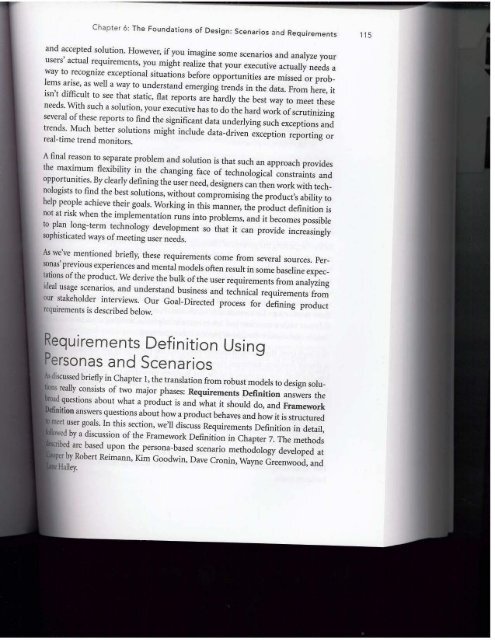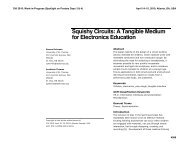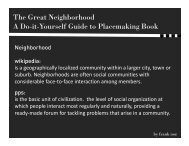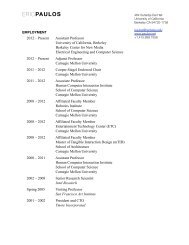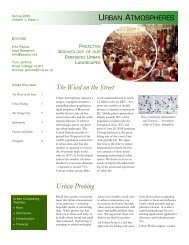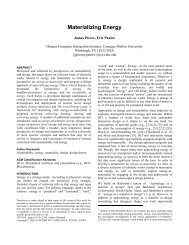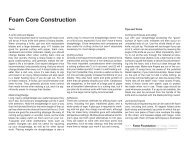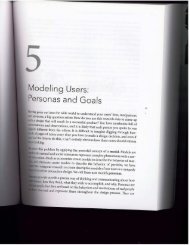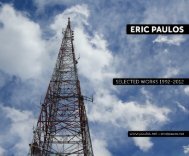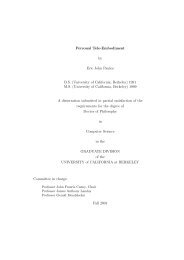The Foundations of Design: Scenarios and Requirements
The Foundations of Design: Scenarios and Requirements
The Foundations of Design: Scenarios and Requirements
- No tags were found...
You also want an ePaper? Increase the reach of your titles
YUMPU automatically turns print PDFs into web optimized ePapers that Google loves.
Chapter 6: <strong>The</strong> <strong>Foundations</strong> <strong>of</strong> <strong>Design</strong>: <strong>Scenarios</strong> <strong>and</strong> <strong>Requirements</strong> 115<strong>and</strong> accepted solution. However, if you imagine some scenarios <strong>and</strong> analyze yourusers' actual requirements, you might realize that your executive actually needs away to recognize exceptional situations before opportunities are missed or problemsarise, as well a way to underst<strong>and</strong> emerging trends in the data. From here, itisn't difficult to see that static, flat reports are hardly the best way to meet theseneeds. With such a solution, your executive has to do the hard work <strong>of</strong>scrutinizingseveral <strong>of</strong> these reports to find the significant data underlying such exceptions <strong>and</strong>trends. Much better solutions might include data-driven exception reporting orreal-time trend monitors.A final reason to separate problem <strong>and</strong> solution is that such an approach providesthe maximum flexibility in the changing face <strong>of</strong> technological constraints <strong>and</strong>opportunities. By clearly defining the user need, designers can then work with technologiststo find the best solutions, without compromising the product's ability tohelp people achieve their goals. Working in this manner, the product definition isnot at risk when the implementation runs into problems, <strong>and</strong> it becomes possibleto plan long-term technology development so that it can provide increasinglysophisticated ways <strong>of</strong>meeting user needs.As we've mentioned briefly, these requirements come from several Sources. PerSOnas' previous experiences <strong>and</strong> mental models <strong>of</strong>ten result in some baseline expectations<strong>of</strong>the product. We derive the bulk <strong>of</strong>the user requirements from analyzingideal usage scenarios, <strong>and</strong> underst<strong>and</strong> business <strong>and</strong> technical requirements fromour stakeholder interviews. Our Goal-Directed process for defining productrequirements is described below.<strong>Requirements</strong> Definition UsingPersonas <strong>and</strong> <strong>Scenarios</strong>Asdiscussed briefly in Chapter I, the translation from robust models to design solunsreally consists <strong>of</strong> two major phases: <strong>Requirements</strong> Definition answers thedquestions about what a product is <strong>and</strong> what it should do, <strong>and</strong> Frameworknilion answers questions about how a product behaves <strong>and</strong> how it is structuredmeet user goals. In this section, we'll discuss <strong>Requirements</strong> Definition in detail,ed by a discussion <strong>of</strong> the Framework Definition in Chapter 7. <strong>The</strong> methodslbed are based upon the persona-based scenario methodology developed atr by Robert Reimann, Kim Goodwin, Dave Cronin, Wayne Greenwood, <strong>and</strong>Halley.


